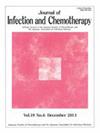2018年日本牙源性感染分离菌药敏监测
IF 1.5
4区 医学
Q3 INFECTIOUS DISEASES
引用次数: 0
摘要
背景:本研究报告了日本牙源性感染分离株的第二次药敏监测结果。方法:选取21家医院的牙周炎(1组,n=33)、冠周炎(2组,n=7)、颌骨炎症(3组,n=83)、颌骨区痰(4组,n=42)共164例牙源性感染标本。结果:共检出515株细菌,分别为120、115、173、38、69株链球菌、厌氧革兰氏阳性球菌、普雷沃氏菌、卟啉单胞菌和梭杆菌。根据临床和实验室标准协会的指导方针确定牙源性感染的敏感细菌与病原体的比例。血管链球菌的易感率为:氨苄西林,98.6%;头孢capene,头孢曲松,美罗培南和多利培南,100%;克拉霉素和阿奇霉素占71.2%;克林霉素占87.7%。氨苄西林对普雷沃氏菌的MIC90值为32 μg/mL,敏感性为65.3%。舒巴坦/氨苄西林的MIC90值为2 μg/mL,敏感性为100%。结论:本研究结果表明,青霉素与β-内酰胺酶抑制剂联合使用是治疗牙源性感染和厌氧菌群引起的口腔感染的一线抗菌药物,其耐药性较低。本文章由计算机程序翻译,如有差异,请以英文原文为准。
Antimicrobial susceptibility surveillance of bacterial isolates recovered in Japan from odontogenic infections in 2018
Background
This study reports the findings of the second antimicrobial susceptibility surveillance study of isolates recovered from odontogenic infections in Japan.
Methods
A total of 164 odontogenic infections samples including periodontitis (group 1, n = 33), pericoronitis (group 2, n = 7), jaw inflammation (group 3, n = 83), and phlegmon in the jawbone area (group 4, n = 42) from 21 facilities were included in the study.
Results
Antimicrobial susceptibility testing was performed on 515 isolates, consisting of 120, 115, 173, 38, and 69 Streptococcus spp., anaerobic gram-positive cocci, Prevotella spp., Porphyromonas spp., and Fusobacterium spp. isolates, respectively. The ratio of susceptible bacteria to causative agents of odontogenic infections was determined in accordance with the guidelines of the Clinical and Laboratory Standards Institute. The susceptibility rates of Streptococcus anginosus were as follows: ampicillin, 98.6 %; cefcapene, ceftriaxone, meropenem, and doripenem, 100 %; clarithromycin and azithromycin, 71.2 %; and clindamycin, 87.7 %. The MIC90 value for ampicillin for Prevotella spp. was 32 μg/mL, with a susceptibility rate of 65.3 %. The MIC90 value for sulbactam/ampicillin was 2 μg/mL, with a susceptibility rate of 100 %.
Conclusions
The findings of the present study indicate that the resistance to the combination of penicillins and β-lactamase inhibitors, the first-line antimicrobial agents for odontogenic infections and oral infections caused by anaerobic flora, are low.
求助全文
通过发布文献求助,成功后即可免费获取论文全文。
去求助
来源期刊

Journal of Infection and Chemotherapy
INFECTIOUS DISEASES-PHARMACOLOGY & PHARMACY
CiteScore
4.10
自引率
4.50%
发文量
303
审稿时长
47 days
期刊介绍:
The Journal of Infection and Chemotherapy (JIC) — official journal of the Japanese Society of Chemotherapy and The Japanese Association for Infectious Diseases — welcomes original papers, laboratory or clinical, as well as case reports, notes, committee reports, surveillance and guidelines from all parts of the world on all aspects of chemotherapy, covering the pathogenesis, diagnosis, treatment, and control of infection, including treatment with anticancer drugs. Experimental studies on animal models and pharmacokinetics, and reports on epidemiology and clinical trials are particularly welcome.
 求助内容:
求助内容: 应助结果提醒方式:
应助结果提醒方式:


